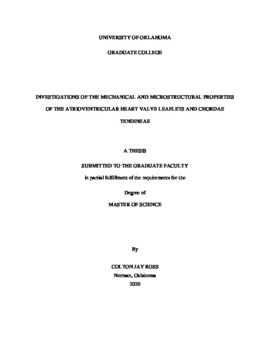| dc.description.abstract | The unidirectional blood flow through the heart is facilitated by the atrioventricular heart valves – namely the mitral valve and the tricuspid valve. The two atrioventricular heart valves (AHVs) are composed of soft tissue leaflets that cyclically open and close throughout the cardiac cycle. The leaflets are supported in their functions by the chordae tendineae, which attach to the papillary muscles to distribute force loads that occur during systolic closure. The dysfunction of any of these valvular components can lead to retrograde blood flow during the valve closing, otherwise known as heart valve regurgitation. Current therapies for heart valve regurgitation range from repair of the native valve, to replacement by a mechanical or biological prosthesis, both of which suffer from different ailments including short- to long-term recurrence of the original pathological condition. Improvements of such therapies are contingent on a better understanding of the biomechanics of the atrioventricular heart valves, including the tissue mechanical behaviors, tissue microstructures, and the relationships between the mechanics and the microstructure. To date, there is lacking information in literature regarding the complex mechanics, and mechanics-microstructure behaviors of these tissues. This thesis research addresses this gap in knowledge through three studies: (i) biaxial mechanical testing of AHV anterior leaflets to understand regionally-varying mechanical properties, the mechanics of individual leaflet layers, and the mechanical contributions of the glycosaminoglycans to the organ-level behaviors; (ii) cyclic, uniaxial tensile testing of the chordae tendineae using a unique tine-based leaflet-chordae-papillary muscle entity approach; and (iii) quantifications of the load-dependent changes in the collagen fiber architectures of the chordae-leaflet insertion region. In the first study series, we found that the AHV anterior leaflets had spatially-varying mechanics with central regions of the tissue being more anisotropic than the edge regions, as evident trough the anisotropy index, with the tricuspid valve anterior leaflet (TVAL) demonstrating an average anisotropy index of 1.09 in central regions and 1.02 in edge regions. We also observed that the atrialis/spongiosa layer was more compliant and more anisotropic than the fibrosa or ventricular layers. For example, in the TVAL we saw the atrialis/spongiosa layer was 9.0% and 12.3% more compliant in the peak stretch in the circumferential and radial directions, respectively, than the fibrosa/ventricularis layers. In addition, we saw glycosaminoglycan-deficient leaflets had higher extensibility (TVAL: 4.7% and 7.6% differences in the circumferential and radial peak stretches, respectively) and lower stress-relaxation behaviors (TVAL: 13.0% and 12.0% differences in the circumferential and radial relaxation, respectively). In the second study, we found that testing the chordae tendineae using the leaflet-chordae-papillary muscle procedure, preserving potential in vivo mechanical interactions, resulted in different uniaxial tensile behaviors than in previous studies, and that the tissue stretches were non-uniform across the chordae domain (average peak stretch of 1.09 for the TVAL strut chordae). In the third study, we effectively quantified the load-dependent collagen fiber architecture changes across the same specimen and found that the center of the insertion had higher increases in fiber alignment than the edges of the insertion. Furthermore, we quantified the collagen fiber architecture changes through the degree of optical anisotropy and noticed increases in alignment up to 37.7% for the TVAL strut chordae-leaflet insertion between the mounting and peak loading configurations. Findings on the collagen fiber architectural changes are useful for better insight and connections between tissue mechanics and microstructure. In summary, these investigations greatly enhance the understanding of AHV biomechanics, which will be useful for the development of computational models and the refinement of therapeutics. | en_US |

